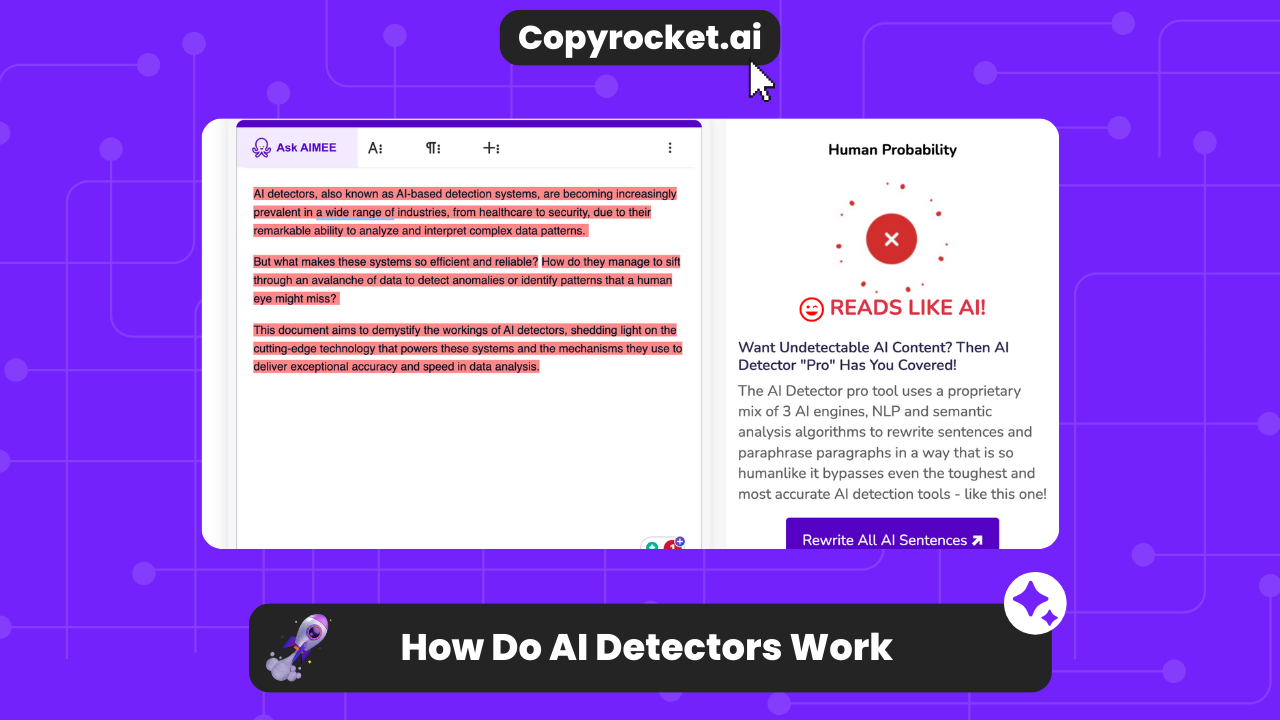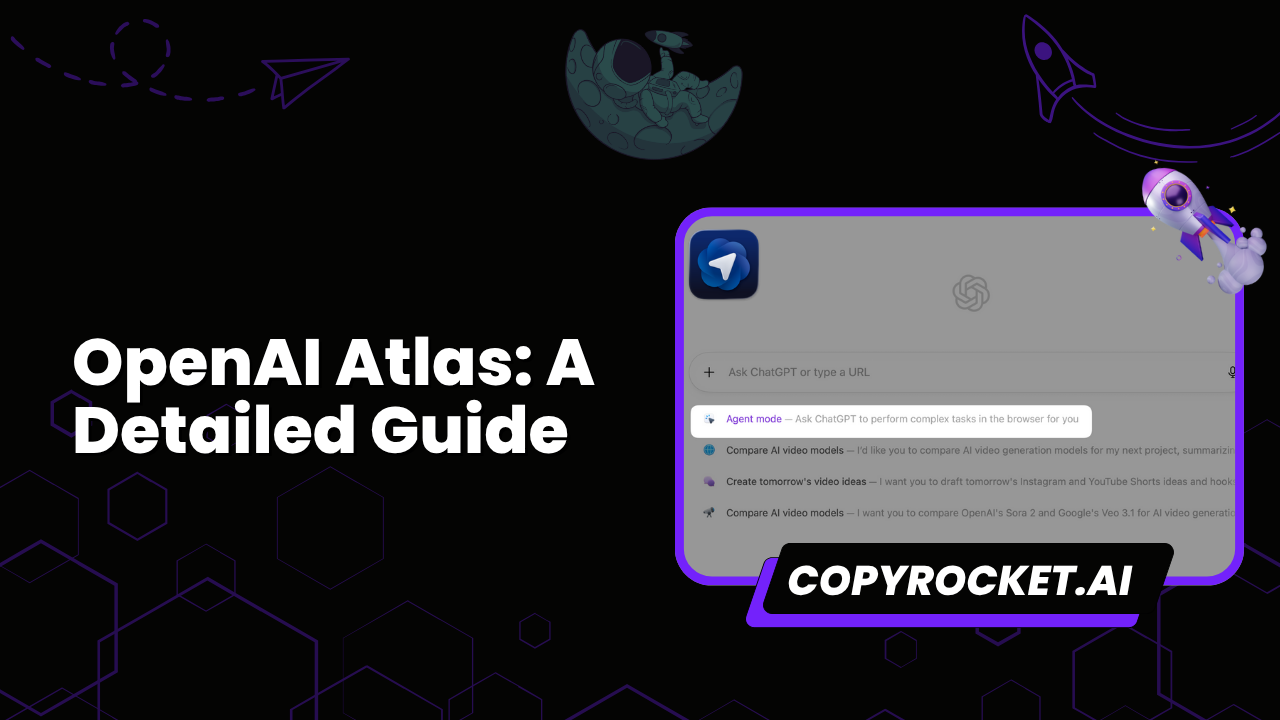AI detectors, also known as AI-based detection systems, are becoming increasingly prevalent in a wide range of industries, from healthcare to security, due to their remarkable ability to analyze and interpret complex data patterns.
But what makes these systems so efficient and reliable? How do they manage to sift through an avalanche of data to detect anomalies or identify patterns that a human eye might miss?
This document aims to demystify the workings of AI detectors, shedding light on the cutting-edge technology that powers these systems and the mechanisms they use to deliver exceptional accuracy and speed in data analysis.
Also read How to Pass AI Detection with ChatGPT (100% Working)
What are AI Detectors?

AI detectors, or AI content detectors, are sophisticated AI tools that have increasingly found application in diverse fields. These systems are based on a set of algorithms that enable them to analyze, interpret, and make decisions based on extensive data.
They excel at detecting patterns, anomalies, or specific features in AI-generated text or human-written text. These AI detection tools often outperform human capabilities, given their ability to process large volumes of data swiftly and accurately.
Also read, How to Humanize ChatGPT Text (2 Free Methods)
Why is text detection in AI so crucial?
AI is being increasingly utilized in various fields such as journalism, digital marketing, academia, and even law. Surprisingly, some lawyers have attempted to leverage AI in the courtroom, citing fake cases.
While AI-generated content isn’t inherently bad, it’s crucial to have the ability to distinguish between AI and human writing.
The rise of AI writing has necessitated the development of such detection tools to identify and distinguish AI-generated content from human writing.
One major concern is academic integrity, as using AI-generated content without proper attribution can have severe consequences.
Interestingly, a staggering 65.8% of people believe that AI content is on par with or even superior to human-written content.
In some cases, even academic researchers struggle to discern the difference. This raises safety implications, particularly if ChatGPT-produced thesis papers are published without scrutiny. Even if AI can be used to cite sources, it brings about ethical dilemmas.
To address these concerns, employing a ChatGPT detector can help evaluate the effectiveness of content against a certain human standard. However, the remarkable progress in AI writing poses challenges to this approach.
Also read, How to Ask AI a Question (6 Prompts)
How do AI detectors work?
Let’s delve deeper to uncover what’s happening behind the scenes. Essentially, these tools operate in various ways. Here are the two primary concepts:
Linguistic Analysis: This involves examining the structure of sentences to identify semantic meaning or repetition.
Comparative Analysis: By comparing with the training dataset, similarities with previously identified instances are identified.
These techniques are commonly employed when training a model to detect AI-generated content using the above-mentioned concepts.
Classifiers
Classifiers play a fundamental role in the functioning of AI detectors. These classifiers are essentially trained models that determine whether a piece of content is AI-generated or human-written based on the features extracted from the text.
Training Phase
In the training phase, the classifier is exposed to large volumes of data, which include both human-written and AI-generated content. This content is already labeled, indicating whether it is human or AI-generated. The classifier analyzes these texts and learns to identify patterns or features that distinguish one from the other.
Feature Extraction
Features can include various elements such as the complexity of the sentence structure, vocabulary richness, frequency of unique phrases, or even more subtle cues like the rate of repetition or consistency in style. The specific set of features used depends on the type of AI being detected and the design of the classifier.
Classification
Once the classifier is thoroughly trained, it can be used to analyze new, unlabeled content. It extracts features from this content and applies the decision rules it learned during training. If the features align more closely with those typical to AI-generated text, the classifier labels the content as such, and vice versa.
Classifiers can vary in complexity, from simple linear classifiers to complex neural network models. Regardless of the type, the objective remains the same: to accurately distinguish AI-generated text from human-written content.
Embeddings
Embeddings in AI detection refer to mathematical transformations that convert text data into numerical vectors. These vectors, or ’embeddings’, capture the semantic similarity between words or sentences, enabling AI detectors to recognize patterns and make predictions based on these patterns.
Machine learning algorithms, such as those used in AI detectors, can understand and work with numbers but not text. So, to analyze text data, these algorithms need a way to convert words into numerical form. This is where embeddings come into play.
In the context of AI detection, embeddings can help in illuminating the intrinsic characteristics of AI-generated content. For instance, an AI text generator may use certain phrases, sentence structures, or words more frequently than a human writer would.
By converting this text into numerical form, embeddings can reveal these patterns, allowing the AI detector to identify whether the content is AI-generated.
There are various types of embeddings, such as Word2Vec, GloVe, and FastText, that convert words into vectors based on different algorithms. However, the underlying principle is the same: they represent words in a way that captures their meanings, based on their context within the text.
With embeddings, AI detectors can process and analyze large volumes of text data, effectively distinguishing between human-written and AI-generated content. This forms a crucial part of the AI detection process, enhancing the accuracy and effectiveness of these systems.
Perplexity
Perplexity is another crucial metric in AI detection. It’s essentially a measure of how well a probability model predicts a sample. It’s often used in Natural Language Processing (NLP) tasks to assess how well a model understands text.
In the context of AI detection, perplexity serves as a statistical tool to measure the ‘uncertainty’ of an AI model in predicting the following word in a sentence. Lower perplexity scores indicate that the model has a high level of confidence in its prediction, suggesting that the text may have been generated by an AI model.
Conversely, higher perplexity scores might indicate that the text was written by a human, as humans often use more unpredictable and varied language.
During the detection process, the detector analyzes the text and calculates the perplexity. If the calculated perplexity falls below a certain threshold, the detector labels the content as AI-generated. On the other hand, if the perplexity is above the threshold, the detector labels it as human-written.
It’s important to note that while perplexity can be a powerful tool in AI detection, it’s not infallible. Trained human writers can sometimes mimic the predictability of AI text generators, and advanced AI models can sometimes produce text that is unpredictable and rich in variation, just like human writing. Therefore, perplexity is often used in combination with other detection methods for the best results.
Burstiness
Burstiness plays a pivotal role in AI detection, serving as a statistical measure that can help distinguish AI-generated text from human-written content. The term ‘burstiness’ in this context refers to the tendency of certain words or phrases to appear in clusters or ‘bursts’ within a text.
AI text generators, when creating content, sometimes repeat the use of certain words or phrases nearby, creating a ‘burst’ of these terms. On the other hand, human writers typically use a more diverse vocabulary and have a lower tendency to use the same terms in quick succession.
In the process of AI detection, a burstiness analysis is conducted on the given text. This involves calculating the frequency of each word or phrase and how closely these occurrences are clustered together.
If the text shows a high level of burstiness (i.e., frequent repetition of certain terms near), the detector might label the content as AI-generated. Conversely, if the text exhibits low burstiness (i.e., a more diverse vocabulary with less repetition), the detector is more likely to label it as human-written.
This method, while useful, is not without its limitations. Advanced AI models are becoming increasingly sophisticated and capable of mimicking human writing styles, including vocabulary diversity.
Therefore, like perplexity, burstiness is typically used in conjunction with other detection methods to enhance accuracy and reliability in AI detection.
Is AI Detection Reliable and Accurate?
The reliability and accuracy of AI-generated content detection largely depend on the sophistication of the AI tool employed. These tools, powered by advanced machine learning models, leverage Natural Language Processing techniques to detect patterns typical to AI language models.
For example, popular AI detectors can pinpoint the frequent use of the same words or phrases—a characteristic often seen in text generated by AI.
However, as AI language models become more complex, they are capable of mimicking the writing process of humans, even making more creative language choices that can confuse detection models.
This is especially prevalent with large language models which are designed to understand context and make intelligent next-predicted word choices, similar to a human writer.
Moreover, as AI continues to evolve, the probability distribution of words in a sentence generated by AI no longer follows predictable patterns. This has raised concerns about the potential misuse of AI in spreading fake news or misinformation, making the function of detector tools crucial. However, these detection models are often playing catch up with the rapid advancements in AI technology.
While some popular AI detectors provide a free tool to flag human-written text as potentially generated by a computer program, they are not infallible. This constant game of cat and mouse between AI content generation and detection underscores the need for continued research and development in this field to ensure accurate and reliable detection of AI-generated content.
The Future of AI Detectors
The future of AI detectors, particularly those focused on AI content detection, is poised for significant advancement. These tools will become increasingly sophisticated in detecting AI writing and distinguishing it from human-authored content.
AI writing tools tend to produce certain patterns, such as sentence length and repetitiveness, which AI detectors can flag. Detecting AI writing manually can be challenging, but content detection tools, powered by artificial intelligence, are designed to automate this process.
Media and journalism organizations are among the significant users of these tools, employing them to ensure the authenticity of content and mitigate the spread of misinformation.
Tools like plagiarism checkers are also incorporating AI text detection capabilities to differentiate between AI-generated and human-written content. However, like all technology, these tools are not without flaws. They may sometimes produce false positives, flagging human-written text as AI-generated content.
Artificial writing is not confined to text; it’s also prevalent on social media platforms, creating a need for AI detectors that can work across different media types. Law enforcement agencies are also exploring these tools to detect patterns in communication, aiding in investigations.
Conclusion
In conclusion, the workings of AI detectors, particularly in the context of distinguishing AI-generated content from human-authored text, is a blend of sophisticated machine learning models and language models. With the advent of more advanced AI, these detection tools face the challenge of discerning AI content that increasingly mimics human writing.
The rise of AI-generated content poses risks to search engine optimization. Low-quality, repetitive content can flood the internet, damaging user experience. The misuse of AI to spread misinformation is a pressing concern, highlighting the need for diligent research and development in AI detection. Despite challenges, the future of AI detectors holds promise for accurate and reliable tools.
Frequently Asked Questions
What is the primary method that AI detectors use to distinguish AI-generated content from human-written text?
AI detectors primarily use Natural Language Processing (NLP) to distinguish AI-generated from human-written text. They analyze patterns typical to AI, such as burstiness—the tendency of certain words or phrases to appear in clusters within a text.
How reliable and accurate are AI detectors?
The reliability and accuracy of AI detectors depend largely on their sophistication. While these tools can pinpoint characteristics often seen in AI-generated text, such as frequent repetition of certain phrases, they can be tricked by the advanced AI models that are capable of mimicking human writing styles.
What limitations do AI detectors face?
AI detectors face the challenge of keeping up with rapidly advancing AI models, which are increasingly able to mimic human writing styles and produce unpredictable word distributions. This has led to difficulties in accurately detecting AI-generated content, especially in the context of misinformation spread.
What implications does AI-generated content have on search engine optimization (SEO)?
The rise of AI-generated content can potentially flood the internet with low-quality, repetitive content, which can harm user experience and negatively impact SEO. This underscores the need for effective AI detectors to ensure the integrity of online content.





